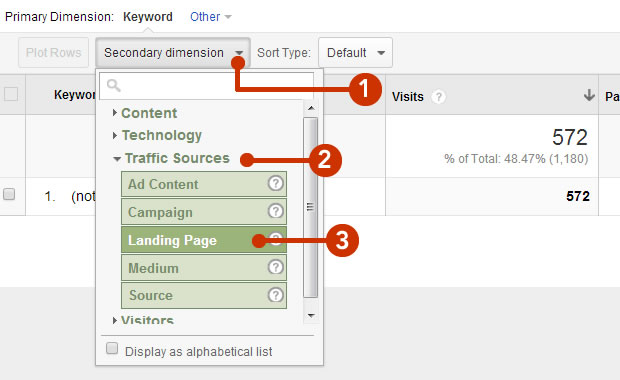Unlock Deeper Insights With Secondary Measurement in Google Analytics
With the substantial area of information offered in Google Analytics, the application of second dimensions can significantly improve your logical capabilities. By strategically including additional dimensions right into your analysis, you can uncover beneficial insights that might or else remain obscure - Secondary Dimension in Google Analytics.
Recognizing Primary Vs. Additional Measurements
When analyzing data in Google Analytics, it is necessary to distinguish between second and main dimensions to acquire much deeper insights into user behavior. Primary dimensions are the primary classifications whereby you can see your data, such as source/medium, gadget, or touchdown web page. These dimensions provide the essential framework for arranging and recognizing your data. On the other hand, second dimensions permit you to additional study your primary measurement information. By including a second measurement, you can layer on added details to your main dimension, allowing a much more granular evaluation. If your main dimension is the source/medium through which customers showed up on your website, adding a secondary measurement like geographical place can reveal where those customers are located geographically. When looking at the primary measurement alone, this added layer of info can aid you determine fads, patterns, or anomalies that may not have been apparent. Consequently, leveraging both additional and key dimensions in Google Analytics is vital for extensive data analysis and educated decision-making.
Making Use Of Additional Measurements Effectively
By including additional dimensions alongside primary dimensions, marketers and experts can dive deeper right into the specifics of customer communications on their internet sites. Secondary measurements permit individuals to section and filter main dimension data further, supplying a more detailed sight of individual interactions, demographics, and actions.
Moreover, second dimensions make it possible for individuals to contrast and contrast different information points within a solitary record, promoting a much more extensive evaluation of user habits patterns. By leveraging second dimensions successfully, businesses can reveal covert understandings, optimize their marketing techniques, and improve the overall user experience on their internet sites.
Checking Out Common Second Dimension Combinations
To further analyze customer habits and fads in Google Analytics, it is important to check out common mixes of second measurements. Some common additional measurement mixes that offer useful understandings consist of evaluating website traffic sources with customer locations to comprehend where internet site site visitors are coming from geographically and just how they found the site. Checking out user habits metrics with secondary measurements such as rate of interests or demographics can assist in targeting particular target market sections more successfully.
Applying Additional Measurement in Personalized Reports
Utilizing second dimensions in customized records permits a much more thorough analysis of data in Google Analytics, improving the depth of insights obtained. When developing custom reports in Google Analytics, integrating second measurements can supply a more thorough view of just how different dimensions interact with each various other. This feature allows customers to dig deeper into their data and uncover important connections that may not be right away apparent.
By using second measurements in custom-made reports, users can gain a better understanding of their site or application web traffic. Incorporating the key measurement of Full Report "source/medium" with the second measurement of "touchdown page" can reveal which touchdown pages are performing best for traffic coming from certain resources. This understanding can assist marketers maximize their projects and improve overall conversion prices.

Enhancing Information Visualization With Secondary Dimension
When discovering information in Google Analytics customized records, incorporating additional measurements not just offers an extra comprehensive analysis yet also improves the graph of insights with information visualization. By including a secondary measurement to your records, you can enrich the method information is offered, making it simpler to recognize patterns, trends, and connections within your web site's efficiency metrics.
Second measurements can help you segment your information further, enabling a much deeper understanding of user behavior and communications on your site. This improved degree of granularity can be particularly helpful when trying to separate certain variables that might influence your web site's performance - Secondary Dimension in Google Analytics.

Conclusion
Finally, leveraging additional dimensions in Google Analytics permits for an extra thorough analysis of data, bring about deeper insights and even more informed decision-making. Secondary Dimension in Google Analytics. By including additional layers of info to primary information collections, marketers and analysts can uncover surprise trends, patterns, and connections that supply a granular view of individual actions and interactions. This enhanced level of understanding enables optimization of projects and tailored methods for specific audience sections, ultimately improving performance and conversion rates
On the other hand, second measurements permit you to websites more dissect your primary measurement data. By adding an additional measurement, you can layer on additional info to your main measurement, enabling a more granular evaluation. If your main measurement is the source/medium through which individuals showed up on your site, including a second measurement like geographic place can disclose where those customers are Homepage situated geographically. By incorporating second dimensions alongside primary dimensions, experts and marketers can delve deeper right into the specifics of individual communications on their web sites. Secondary dimensions allow users to segment and filter main measurement data even more, providing a more in-depth sight of customer demographics, communications, and habits.